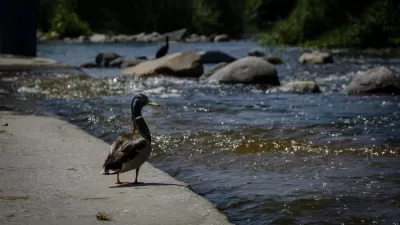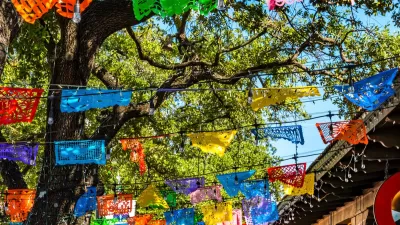As excitement around the L.A. River revitalization heats up, neighbors of the once-neglected channel wonder who will benefit from the billion-dollar redevelopment.
Even partial restoration of the Los Angeles River has been promised to yield a bounty of benefits in the areas of public health, water conservation, and urban placemaking. But a piece in The Nation suggests that communities who lived near the channel through its less glamorous days may never reap those benefits.
The article explores what it calls "the striking alignments of interest among the mayor, the River Corp., and the city's power elite with regard to the project," noting the seeming conflicts of interest in the non-profit implementing the restoration plan, as well what looks like city cooperation with wealthy developers in buying, selling, and rezoning properties in the increasingly desirable area:
"[T]he fear of many current residents [is] that because real-estate interests have been free to speculate and exert influence without adequate public oversight, the very people who fought for open spaces in their neighborhoods along the river—among the least wealthy and least healthy in LA, and with the fewest public parks—may not be able to afford to stick around long enough to enjoy them."
Is there any chance that the influx of money around the river will reach existing river communities? Perhaps: The city has considered designating the area as a new type of district, where tax revenues would be dedicated to infrastructure improvements and community-based projects.
Community faith in the river's coming "rebirth" hardly improved with the news that architect Frank Gehry would conduct the restoration. Some viewed that decision—which wasn’t made public for nearly a year—as a betrayal to years of community work; activist Lewis MacAdams called it "the epitome of wrong-ended planning."
Kreitner's piece weaves these threads into a suggestive narrative that places fears surrounding the river project in the context of other casualties of L.A.'s relentless march toward progress—Chavez Ravine, Chinatown, Bunker Hill—and employs an informative cast ranging from local leaders and community members to St. Francis of Assisi and Mary Pickford.
FULL STORY: Will the Los Angeles River Become a Playground for the Rich?

Alabama: Trump Terminates Settlements for Black Communities Harmed By Raw Sewage
Trump deemed the landmark civil rights agreement “illegal DEI and environmental justice policy.”

Study: Maui’s Plan to Convert Vacation Rentals to Long-Term Housing Could Cause Nearly $1 Billion Economic Loss
The plan would reduce visitor accommodation by 25% resulting in 1,900 jobs lost.

Planetizen Federal Action Tracker
A weekly monitor of how Trump’s orders and actions are impacting planners and planning in America.

Waymo Gets Permission to Map SF’s Market Street
If allowed to operate on the traffic-restricted street, Waymo’s autonomous taxis would have a leg up over ride-hailing competitors — and counter the city’s efforts to grow bike and pedestrian on the thoroughfare.

Parklet Symposium Highlights the Success of Shared Spaces
Parklets got a boost during the Covid-19 pandemic, when the concept was translated to outdoor dining programs that offered restaurants a lifeline during the shutdown.

Federal Homelessness Agency Places Entire Staff on Leave
The U.S. Interagency Council on Homelessness is the only federal agency dedicated to preventing and ending homelessness.
Urban Design for Planners 1: Software Tools
This six-course series explores essential urban design concepts using open source software and equips planners with the tools they need to participate fully in the urban design process.
Planning for Universal Design
Learn the tools for implementing Universal Design in planning regulations.
Caltrans
Smith Gee Studio
Institute for Housing and Urban Development Studies (IHS)
City of Grandview
Harvard GSD Executive Education
Toledo-Lucas County Plan Commissions
Salt Lake City
NYU Wagner Graduate School of Public Service





























